#geared steam locomotive
Explore tagged Tumblr posts
Text
[In order of appearance]
Lima Locomotive Works - C-80-3
Climax Locomotive Works - Class C (70-3)
Lima Locomotive Works - C-70-3, PC-13, C-90-3
Steamy Power Locomotive 🚂
#steam locomotive#steam#geared steam locomotive#lima locomotive works#climax locomotive works#i'm kinda wondering the [X]-[tons]-[bogies] classification is just how cass does it and not how the manufacturer does it.#assuming the manufacturers even have names for these beyond a build number#cass scenic railroad#oh well
2K notes
·
View notes
Text

Misty Islands Logging Company No.2 Bernard --- Misty Islands Scenic Railway No.2 Bernard or "Bash"
One of the two surviving yarding locomotives operated by the Misty Islands Logging Company, Bernard has been there from almost the beginning, and though he didn't help lay the original tracks to the first logging camp, he did help build much of the rest of the railway. He and Ferdinand took great pride in their work, and hated the implication that it was "bad" or "spaghetti" or "so tightly curved that Rex, Mike, and Bert would clench their spring rigging".
There is a misconception that Bash and Dash (David) are twins, but though the share the same overall layout and are very close friends and get up to the same kind of mischief that one would expect from the china clay twins, David and Bernard have some significant differences which will be shown eventually.
This format of locomotive--a small 0-4-0, often geared, with a yarding winch on the front, were very common on the Misty Islands Logging Railroad. Unfortunately, only two survive.
#Misty Island#Misty Islands au#rws#ttte#train#steam train#steam engine#steam locomotive#locomotive#logging locomotive#geared locomotive
160 notes
·
View notes
Text









🚂/🌾/🚂|🌾/🚂/🌾|🚂/🌾/🚂
Stimboard of my favorite Locomotive: Nickel Plate Road 765, S-2 class Berkshire built by LLW in 1944. Wish I could have found gifs of the actual train.
~ Ches 🚂
#stim#sensory#stimmy#stimboard#train#locomotives#LLW#berkshire train#berkshire#nickel plate road#steam locomotive#trains#tech#mech#mechanical#machine#metal#gear#silver#steampunk
8 notes
·
View notes
Text
Part 1










(x)
#metal gear#metal gear solid#mgs#kazuhira miller#venom snake#vkaz#this one was sent to me by the same friend bc the micellar water lore is now The Trilogy(tm) and I keep updating her on its number of notes#tho the gamer otacon is slowly preparing to take over#anyway as i said it is now a trilogy. so there's more to come. at some point#i was originally gonna make kaz put some Steam Locomotive Sounds to Sleep - 10 Hours. but 1. I think he'd sleep in silence or#he'd put those Nature sounds instead#& 2. I was getting tired#before I finish - I also intended to give venom a rilakkuma sweater but found out it's rather recent... But snoopy was old enough...#then while looking at snoopy pics I saw the hug one and I had a revelation. like. that's literally them#so that's the backstory to the snoopy vkaz. Thanks for coming to my Ted talk
42 notes
·
View notes
Text
Lima Locomotive Works - C-70-3 (left) & C-150-3 (right) AKA Cass Scenic Railroad No. 4 & 6 Both of these engines are Shays, Geared steam locomotives with several distinct features. They have 2 or 3 pistons (in this case both have 3) mounted vertically on the right side. The boiler is shifted to the left to make room for the pistons. These pistons drive a driveshaft on the outside, which drives the wheels via gears. This design gave you a lot of grip and made the engines pretty light, which was fantastic for small industries like logging and mines, and terrible for the main line due to its low speed.
The fasted a Shay has ever been recorded going is 18 MPH. No. 6 is the largest Shay in existence, and the last one built by Lima.

661 notes
·
View notes
Text
With a grunt they come to a stop at some sort of solid surface imbedded into the hill. Hydra groans and lays flat on their back, looking up at the overcast sky. His vision needs a moment to catch up and recalibrate back into one point of focus.
What a fucking great birthday this has been turning out to be, eh?
Slowly, Hydra sits up and rubs at their aching joints. Their neck needs to be looked at and he is in need of a good shower when he gets back to his shed. Probably a good dusting of his current gear. That would be a good way to end today. Getting a nice warm bath and snuggling up into bed with some comfortable clothes…
That trail of thought ends as he finishes turning around to stare at the object jutting out of the face of the hill.
A distorted face stares back at him. Eaten away synthetic skin and broken eyes revealing a faceless train.
“WOAH- ACK!” Hydra begins to scream but tumbles backwards on their butt. They fall over onto their back with a surprised ‘oof!’
They quickly find their bearings and scramble away from the scrapped train. His breathing hitches as he stares from a safe distance.

A faceless train with corroded and dirty armor and exposed inner workings sits calmly with much of their chest and legs embedded into the dirt. Its jaw is missing a screw and wide open. Sharp triangle locomotive teeth in need of a good shine and sharpening. Hair mattered and chewed up by local pests. Grass, vines, and other plant life twisting atop of what remained of their clothes and armor.
Hydra looks down at the train’s legs and notices more pieces of the train half-buried in the earth. Wires, bolts, nuts, steel, iron, chunks, cloth…
A racing helmet.
Tentatively, the hydrogen tanker crawls towards the rusted helmet. He wipes away at some grime and dirt to reveal the train’s numbers: 2-6-4
A shaky breath escapes him. Steam locomotive wheels in his head churn like gears in his head.
Oh.
He brushes more dirt and crust off of the helmet. It’s burnt here and there with rusting but it’s a clear replica of a steam locomotive.
Now he sits on his knees and holds the helmet in disbelief. Hydra’s eyes drift back towards the decaying train. A racer. A steam locomotive.
Oh.
[From the fan writing 'Another Believer' by AlmondCakeFrosting. Only viewable with an AO3 account.]
#mvf art#stex fic another believer#mvf writing#rusty the steam engine#hydra the hydrogen tanker#hydra the hydrogen truck#stex rusty#stex hydra#starlight express#stex#stex revival#tendersteam#hydrosteam#consider this a test for posting my writing stuff since. ya know. my account is locked for protection#final chapter's coming soon so i wanted to finish this drawing#horror/#eyes/#traditional art
55 notes
·
View notes
Text
The Embodiment of Streamline Moderne
Most steam streamliners have shrouds to bring the engine into a Moderne style. Be that styling the engine to look as new as its consist does on the inside, OR embracing a look that borrows from contemporary diesel power.
Seems the Pennsylvania Railroad T1's were the exact opposite, at least at first. A futuristic design concept by Raymond Loewy was adapted to fit the outline of a steam engine
Just look between these two and the resemblance is clear


The T1's are already fairly modern machines as far as steam locomotives go. True, they are reciprocating machines so they still use cylinders and rods compared to individual steam motors, or a steam turbine drive. However, there's two or three aspects about them to complement their forward styling.
First is the duplex drive. The concept was to create a locomotive that was easier on the track at higher speeds by splitting up the driving wheels. More cylinders are needed, but the actual reciprocating mass is reduced. The T1's weren't the first iterations of this, on or off their home railroad, but they came with something else.
Second is poppet valves; more familiar with stationary steam engines, and persist today in internal combustion engines. Compared to piston valves, poppets allow for more precise timing of admission and exhaust to the cylinder, thus more power can be obtained. Poppet valves were tried a few times in the US in the 20s, and saw use elsewhere, but almost nothing like what the T1's had
Lastly is the Franklin System of Steam Distribution. This is a form of valve gear, large based on Lentz gear as it uses oscillation cams and has valves positions more like a piston. However, there's multiple sets of these valves, and the actual reciporicating mass is miniaturized and housed in a gearbox casing. In addition to the slight power boost offered by poppet valves, this further reduction of weight means the engine puts less energy into moving itself compared to its train. In addition, this protected the motion and meant maintenance requirements were actually lower compared to conventional valve gear.

If you know anything about the T1 that last part may sound odd, but the first engine to use the Franklin system did indeed require less maintenance than others in its division. The streamlining made access tricky, but it was really a problem when it came to making repairs not general maintenance.
All this and more set the T1 apart from anything that came before, or really since. It's only fitting they look the part of being a vision of the future. Just had no idea where the styling originated for them to look so much more modern on the outside, when they were already steps forward on the inside.
The best part about the iconic profile is that it never really left. I don't just mean the later T1's or the similar looking diesels. The prototype T1's kept the Loewy influence up front right til the end. Just iconic

#pennsylvania railroad#trains#steam locomotive#streamline moderne#art deco#futurism#look this is my favorite engine of all time i had to gush about it more than a bluesky thread#railroad
63 notes
·
View notes
Text
Okay, but let's discuss the important questions here:
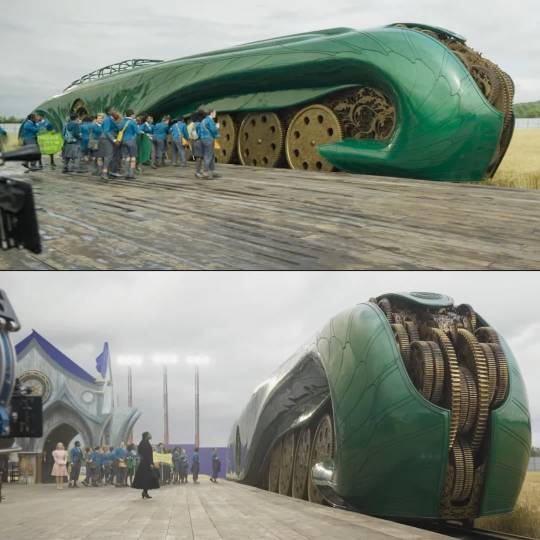
Does the train in Wicked make sense?
…well no, of course not, it's Wicked, I'd be disappointed if it made sense. Way too many gears on that damn thing (gears happen to be expensive), but you know, that's on purpose, that's the point of the whole thing.
I will actually say that it makes more sense than you'd expect at first glance. There's an implication that this is a private special purpose rail vehicle, not the train usually used here, specifically to get Elpheba to Oz. See how the station platform is infinitely long, obviously designed for far longer trains. Between the luxurious interior and the dome-car style canopy, this may be the Wizard's own personal train. I don't think he'd actually use it, but it would make sense for him to have one. Like how the Pope in the real world has a rail connection that's completely pointless. This train is definitely the thing to send if you want to impress, well, the only one with actual magical power in the whole kingdom.
And I really love the design of it. It evokes both 1920s and 1930s streamlined locomotives and 1930s streamlined cars like the Bugatti Type 57:

But it also puts its own Art Nouveau spin on it. It's beautiful, intricate, needlessly complicated, the only knock against it is that it doesn't appear to be wheelchair accessible, which is genuinely not great.
There are a lot of questions you could ask about it. Like, why does it appear to have a 2'D2' (that's 4-8-4) wheel arrangement like a tender steam locomotive when it doesn't appear to be one of them, and the rear isn't a tender? Beats me. How is it powered? No clue. Why do the tracks have moving parts? No idea. How does it stay on the tracks, is that why the driving wheels appear to be slanted? Impossible to tell. Isn't this going to be hell on maintenance? Quite possibly. But all of these feel kind of silly to ask in the heightened reality of Wicked.
The important part is that the train is really beautiful and I love it.
36 notes
·
View notes
Text
Dodgy Designs & Dirt

The story of how a crew, beset with turmoil, overcame their locomotive's design flaws. It is written from the perspective of the fireman.
The matter of favourites on the Portethwaite line was a highly opinionated subject and could easily depend on the day.
But it can be agreed by all of the staff that The ‘Brigitte’ was the most polarizing.
When built by Anstis Works, she was designed with aesthetics first and practicality second. None could deny that she was a beautiful engine and passengers came to see her as an icon of the railway and the valley. But any crewman that worked with her on a rainy day saw past the dazzle and might start to resent her.
It mostly came down to her cab. She was built a few miles west of Brighton, and it clearly shows as her outline was influenced by the Stroudley appearance of a cab thinner than the tanks.
A necessity on the LBSCR due to the tunnels at Hastings, but nothing short of impractical on the narrow gauge, for a rainy day meant soggy sleeves for both men on the footplate.
Another abnormality of The 'Brigitte' was her lack of sanding gear, or any sanding pots to speak of. Both of her colleagues possessed sand pots, and No.2; The ‘Bowen Cooke’, even had a sanding mechanism.
Crews would bring with them a small container of sand; not too big or it would eat up precious space in the cab, not too little or they would run out before they got anywhere. If this failed them, the solution was always to use the bucket of sand kept in the guard’s van. It was meant for tackling fires and this practice would likely be frowned upon by Mr and Mrs Health and Safety of today.
However, I recall one trip where even this wasn’t enough.
It was mid-spring and we were now working to the summer timetable, but despite that it had been raining heavily for the last couple of days.
With sleeves rolled up and hats firmly secured around our heads, my driver and I were rostered to take The ‘Brigitte’, 4 coaches and half a dozen wagons to the lake. A load like this was never usually a problem, but we had the misfortune of needing to stop on the gradient at Rockfahm Halt.
We tried to restart but No.1 slipped and stalled and soon I was walking alongside the engine with our pot of sand, trying to throw it onto the railhead whilst avoiding having my hands cut off by the valve gear.
Eventually underway, we steamed into Hardbrooke at 10 minutes past the hour; only 5 minutes late but with the good fortune of the next 3 miles being downhill.
I spent those next few miles building up my fire. The proceeding 4 miles after Butary were the most punishing and we would need all the steam we could manage. Cautious not to slip, my driver slowly eased her out of Butary and we immediately climbed towards the lake. The gradients went from 1 in 77 to 1 in 50 throughout the journey in a sneaky and unceremonious way.
It was one moment we were going fine along a ridge overlooking the river, the next moment the wheels had lost all grip and the train quickly dragged to a halt. Checking the pot, I found to my horror, we had used it all on the climb from Rockfahm halt to Hardbrooke.
Then I remembered, we still had the guard’s bucket of sand in the van. The ridge the train was on meant we could get out of the cab, but we couldn’t walk down the train. I signalled to the guard to bring the bucket to this end. Striding down the corridor through the carriages as far as he could, it was then we encountered our second problem: the first coach in the train was unlike the others. Instead of having balconies at either end and a corridor in between, it had separated compartments.
By now we already had the attention of the passengers, as they all popped their heads out of the windows. Thinking quickly, we employed them to pass the bucket between them from the guard to the engine.
We had to hurry, for as it got further up the coach, it got heavier with all the rain soaking into the sand.
That was when disaster struck; from one burly gentleman it passed to an older gentleman who couldn’t quite match. It dropped, slipped from his hand and tumbled down the ridge, scattering clumps of sand everywhere but the rails we needed it on.
In a moment of dumbfoundedness, my driver could do nothing but quip, “It’s a good thing the guard won’t be needing that sand for fires then.”
We tried to start the train again on our own, but it was no use. The heavy load threatened to pull us back and The ‘Brigitte’ wouldn’t grip.
In a last act of desperation, my driver told me to start digging a hole on his side. “Is now the time to start digging our graves?” I remarked.
“If we can’t use sand, we’ll use dirt. Dig up as much dry dirt as you can and throw it under the wheels.
I got busy frantically digging, and when I came across dry stuff, I threw it under the engine’s wheels. It worked well although at one point I slipped on the mud and only just caught myself.
When you’ve experienced your head next to the whirling and untamed rods of an iron horse, you rather wish you had dug those graves ‘just in case’. Each time she lost her fitting, she lurched and swayed alongside me. It felt like I was a horse jockey and at any moment she would ride up on her trailing wheels and leep towards me. But my driver was a skilled man and steered her to grip the hill.
Leaping onto the footplate with a shovel looking like a space, I held my breath as she galloped up to speed and towards where the line levelled out.
Understandably none of the passengers bound for Ekend really minded that we’d blasted past the halt. It was either that or complain to the snorting beast pulling their train.
There was little time to shunt the wagons and get the train turned around. We refilled our sand pots from the station supply at Leakbeck, and I washed my shovel off under the water crane.
The train arrived back home behind schedule, but fortunately we could eat into our down-time before the next trip.
The rain continued for several days after that and we didn’t retrieve the guard’s bucket until a week later on our day off. Safe to say, the guard really wouldn’t have been putting out any fires with or without it.
(I know I don't post much here, but having a full on story is one worth posting)
Character art by @colloquial-kayak
14 notes
·
View notes
Video
Rare power on the move por Kevin Madore Por Flickr: The 1910-vintage, 55-ton, Moore-Keppel Co. Climax #3 runs light in the little yard at Durbin, West Virginia back in May of 2008, as she was being prepared to haul a tourist train along the Greenbrier River. Owned by the Durbin & Greenbrier Valley Railroad, this cantankerous little tea kettle is one of the rarest types of steam locomotive still in existence, with perhaps 3-4 examples left operating in the entire world. The Climax is a geared locomotive, with a pair of cylinders that power a driveshaft that runs the entire length of the centerline of the locomotive. That driveshaft is geared to all of the wheels, giving the engine excellent power and traction, even on steep grades. It is the locomotive equivalent of an all-wheel-drive car or truck. Climaxes were designed for logging applications and had a reputation for being able to negotiate poorly built track. The #3, pictured here, hauled a tourist train known as the "Durbin Rocket" on an insular portion of the old Chesapeake & Ohio Greenbrier Division for about 14 years, beginning in 2002, and was ultimately sidelined with boiler issues in 2016. Today, she is stored at the Cass Scenic Railroad in Cass, WV, where she awaits the repairs and inspections that would be necessary to get her operational again.
14 notes
·
View notes
Text
Bulleid's Proposed Locomotives
So it turns out Bulleid had so many of his designs dropped for one reason or another, and since I can't stick with a single project for more than a few seconds, I wrote up histories for all of them!
Enjoy the ramblings of a madman who spent a good long while finding free number slots for them.
Southern Railway Warship Class
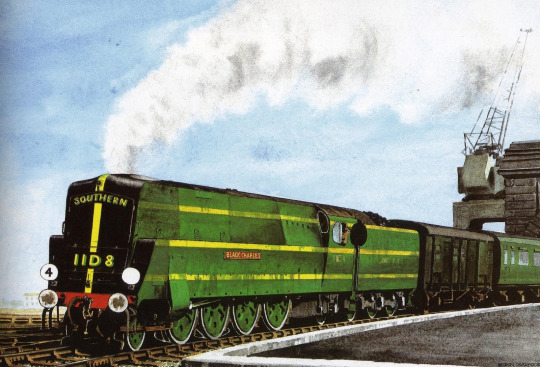
The Southern Railway was the most financially successful of the "Big Four", but this was largely based on investment in suburban and main line electrification. After the successful introduction of the SR Schools class in 1930, the railway had lagged behind the others in terms of modernizing its aging fleet of steam locomotives, as they were more focused on Electrification. Following the retirement of the general manager of the Southern Railway Sir Herbert Walker and Richard Maunsell the Chief Mechanical Engineer (CME) in 1937, their successors considered that the time had come to change this situation. In March 1938 the new general manager Gilbert Szlumper authorized Oliver Bulleid, Maunsell's replacement, to prepare designs for twenty express passenger locomotives. The deteriorating international situation prior to the Second World War was an additional factor in this decision.
Originally, Bulleid had wanted a 4-8-2 Mountain Type, but the Civil Engineering department had resisted this based on size and weight, so a 2-8-2 was chosen instead. Bulleid had worked with Gresley on his P2 2-8-2 express engines, so he already had some background knowledge, especially with the P2’s problems and ideas on how to solve them. Of course, due to the war, they were classified as heavy mixed-traffic engines to get around wartime regulations.
They were built with high-pressure 280 PSI boilers and three 18inx26in cylinders, as well as being the first engines to use Bulleid’s chain-driven valve gear, though the middle cylinder had to be inclined steeply to clear the first driven axle. The boiler was partly welded to save on cost, and the inner firebox was made of steel. The Southern had no facilities to build these boilers, so it was subcontracted to the North British Locomotive Co., as well as Beyer Peacock. They were also fitted with Bulleid’s Air-Smooth Casing. Unlike later designs that utilized this, the casing on the Warships both served their function purpose as labor saving as well as being able to be passed off as some sort of streamlining. How Bulleid got that one through during the war is a mystery! The Warship’s were also the first to use Bulleid’s Firth-Brown Wheels.
10 of these engines were constructed in 1940. More were set to be produced, but once again, the Civil Engineering Department expressed their discomfort at such a large engine running at high speeds with only a single pony-truck in front, despite other engines of a similar design getting on fine elsewhere. This would lead Bulleid to designing and building 30 of his well-known Merchant Navy Class 4-6-2s.
They were named after Warships as a way to increase morale, with 11D1 being officially named “Dreadnought” in April 1940. They performed well in service, hauling heavy passenger and express goods, though the Chain-Driven valve gear was sensitive and required high maintenance, as well as the oil-bath having leaking problems, contributing to wheel-slips(Though the extra wheel helped negate this as well). The casing, while it did save on labor during cleaning, and the more streamlined appearance helped with publicity, it made maintenance hard to carry out. Surprisingly, thanks to their different front ends, they never really experienced drifting smoke like Bulleid’s Pacifics.
All 10 of the engines would be passed into British Railways, numbered 37001-37010, where their duties mostly stayed the same. 11D8 “Black Charles'' took part in the 1948 locomotive exchange trials, where it was compared to LMS Duchess pacifics and LNER A4’s and A2/2s, where it performed favorably, though the chain driven valve gear and its oil bath still caused headaches. After the Crewkerne incident, BR chose a rebuilding program of any engines that still used Bulleid’s Chain Driven motion, however, as the Warships had required far less modifications that the Pacifics, they were on the bottom of the list in the rebuilding program. In the end, only 37003 “Triumph”, 37009 “Warspite”, and 37010 “Exeter” were rebuilt in 1956, 1957, and 1959.
Despite their status as a class with very few engines, all ten would survive until the end of southern steam, going between 1965-1966.
Two are preserved, both being rescued from Barry Scrapyard in Wales. These examples are Class Pioneer 11D1 “Dreadnought”, as well as 11D3 “Triumph”.
Stats
Power Classification - 8MT
Built - 1940 to 1941
Boiler Pressure - 280 PSI
Cylinders (3) - 18in x 26in
Wheels (Driven) - 6ft 2in
Wheels (Leading) - 3ft 1in
Wheels (Trailing) - 3ft 7in
Wheels (Tender) 3ft 7in
Tractive Effort - 40,640 lbf
Total Length - 74ft 8in
Fleet
11D1 (37001) - Dreadnought
11D2 (37002) - Anson
11D3 (37003) - Triumph
11D4 (37004) - Vanguard
11D5 (37005) - Ark Royal
11D6 (37006) - Audacity
11D7 (37007) - Valiant
11D8 (37008) - Black Charles
11D9 (37009) - Warspite
11D10 (37010) - Exeter
Southern Railway Prototype Light Pacific
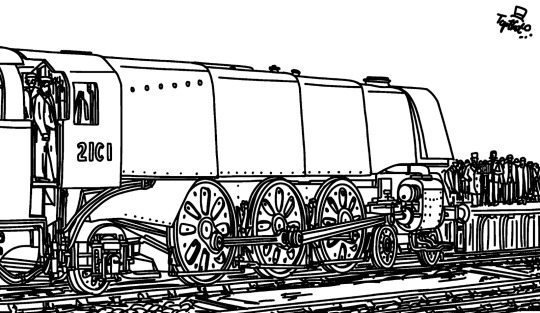
(Pic by Sttophat on twitter)
In 1941, Bulleid had introduced his Warship Mikado's and Merchant Navy Pacific's to become the main motive power for the Southern Railway’s Express passenger trains, though while they performed well, they were restricted by their weight, especially since the condition of the rails were hampered by the Second World War. Initially, trains on the lighter sections were handled by the Q1 0-6-0 freight engines and other, older engines, but they couldn’t handle the faster trains that were anticipated after the war. There was also the planned electrification of certain areas after the war, so the new design also needed to handle freight traffic as well, fast enough to not impede electric services.
What was decided on in the end was a downsized version of the Merchant Navy’s, fitted with the same design theory of the Q1’s to create a “Light Pacific”. The Locomotive was completed in 1942 alongside the Q1’s, and was trialed for a short time before entering service. It was deemed a success, and numbered 21C201. It was powerful enough to handle fast, heavy trains, as well as having an extremely light axle loading for a pacific at 16.5 Tons, enabling it to be used on almost every part of the UK Network as a whole. However, Bulleid decided to go with a different approach, creating simply a downsized Merchant Navy with no Q1 elements. This would increase the axle load, though this wasn’t much of an issue, as the Battle of Britain and West Country Class Light Pacifics still had a high enough route availability for the work they were assigned. Thus, the “Q1 Light Pacific'' would remain a one-off.
During the war, No.21C201 would actually travel a fair amount, and would regularly venture out of Southern territory, its light axle-load coming in handy. After the war however, it would mostly stay in the South. Performance-wise, it seemed to inherit all of the good qualities from the Q1’s and the pacific’s. The light-weight was already a plus, coupled with a great, free-steaming boiler and additions that made the driver and fireman’s life easier. However, it also inherited the bad aspects as well. The chain-driven valve gear was a well-known headache on bulleid locomotives, but there was also the issue that its light-weight caused. The regular Light Pacifics had trouble starting heavy trains thanks to their weight, but No.21C201 had it worse, especially with the well-known issues with the oil bath the valve gear was situated in. The light weight would also affect braking power as well, making unfitted trains harder to stop, a trait inherited from the Q1’s.
No.21C201 (Now Renumbered 34000) was not considered for rebuilding like the other Bulleid Pacifics due to its one-off status. It would be given a general repair in 1960 before spending the rest of its life at Nine-Elms, mainly working express and semi-fast goods trains and the occasional passenger turn during peak period and summer excursions. It was withdrawn from service in 1966 and broken up at Eastleigh.
Stats
Power Classification - 6MT
Built - 1942
Wheels (Driven) - 6ft 2in
Wheels (Leading) 3ft 1in
Wheels (Trailing) - 3ft 7in
Wheels (Tender) - 3ft 7in
Boiler Pressure - 250 psi
Cylinders (3) - 16.5in x 24in
Tractive Effort - 28,145lbf
Total Built - 1
Southern Railway L1 Class
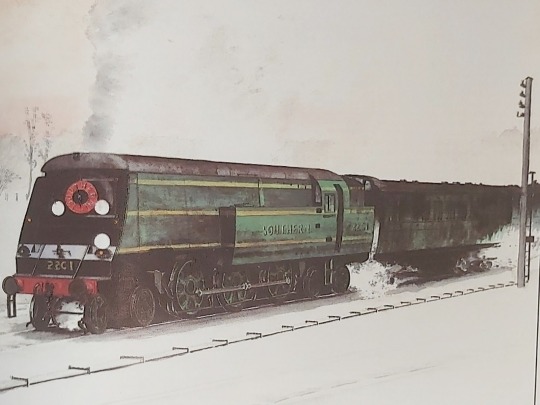
Bulleid designed these locomotives during the Second World War, but construction didn’t begin until 1946. They shared many components with Bulleid’s Q1 0-6-0 goods engines, and were essentially the Q1’s with an Air-Smoothed Casing and a bigger boiler (though the firebox was identical with that of a Q1’s).
Twelve of these engines would be constructed between 1946 and 1948, with the final 3 being built by British Railways. They were originally numbered 22C1 to 22C12, though they were renumbered in 1949 to 36101 to 36112. They were originally meant for short distance goods and passenger services, though they never really found their footing in this role. The passenger trains that usually necessitated big tank engines were already being handled by electric engines, and everything else usually required smaller and lighter engines, which meant that, despite inheriting the power and efficiency of the Q1, the added weight and size meant that they were barred from where they could be most effective. The goods work they were meant for were also in the care of both Q1’s and Maunsell’s Q Class, as well as the many N class moguls already in service. In the end they spent their time hopping from shed-to-shed before settling on ex-LSWR territory, and even venturing into Western Region territory.
They were withdrawn between 1962-1964. Only one survives, 22C9 (36109) on the Bluebell Railway.
Stats
Power Classification - 5F 4P
Built - 1946 to 1948
Boiler Pressure - 230 PSI
Cylinders (2) - 19in x 26in
Wheels (Driven) - 5ft 1in
Wheels (Bogies) - 3ft 1in
Tractive Effort - 30,080 lbf
Southern Railway Dock Class
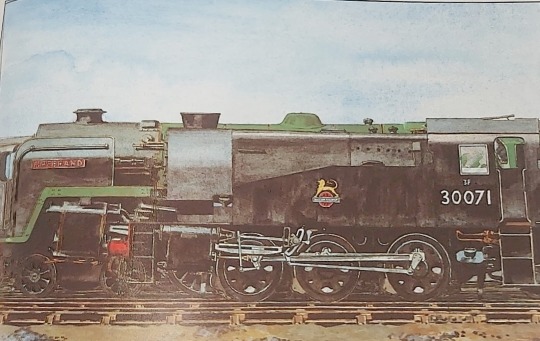
After the Second World War, many of the Southern Railway’s shunters (mainly those at Southampton) inherited from pre-grouping companies were worn out and needed overhauling. As such, Bulleid opted to replace them outright with his own design of 0-6-0T, with a short wheelbase of 10 feet to enable it to negotiate the tight curves. Like many of Bulleid’s designs, he equipped it with a relatively high boiler pressure.
Six would enter service in 1946, and while a total of 18 were planned, this would never come to be, as Eastleigh works was not in a position to build new locomotives with the backlog from the war. In the end, the southern found it cheaper to purchase ex-USATC S100 dock shunters, as they fulfilled most of the requirements needed.
They were numbered C201 to C206, and were renumbered to 30071 to 30076 in British Railways days. The first, 30071, was built with the Idaglass boiler lagging and casing as used in the Q1 class, while the other 5 were built with conventional boiler lagging and tanks. 30071 would be rebuilt like the others in 1953.
The class would lead uninteresting lives as dock shunters in Southampton and Dover until their withdrawal between 1961-1962. One was initially purchased for preservation but the deal fell through. None are preserved.
Stats
Power Classification - 3F
Built - 1946
Boiler Pressure - 220 PSI
Cylinders (2) - 16in x 24in
Wheels (Driven) - 4ft 6in
Tractive Effort - 21,276 lbf
#oliver bulleid#what-if engines#train#I have way more of these if you guys want to see them#or maybe I'll just do it anyways lol
54 notes
·
View notes
Text

NWR No.1 and SLYM No.11513 at a dual gauge interchange just outside of the city center.
SLYM No.11513 is an Advanced Steam Locomotive native to Gymnome--a coal-burning steam engine operating at high pressure, with technological improvements to allow it to rival the efficiency and ease of use of a diesel locomotive, such as electronic controls, compound expansion of steam, a gas producer combustion system firebox, dual exhaust, and automatic firing and oiling. 11513 was built some time in the 2340s, and survives to 2381 as a museum piece.
NWR No.1 is a much older locomotive and from another planet altogether, built 1915 for the LBSC railway as a one-off prototype for a six-coupled shunter to replace the aging Terriers and to supplement the much larger E2-tanks. NWR No.1 made it to the North Western Railway not long after it was built, having been allocated there for the war effort. It is not clear how a locomotive built 465 years in the past on planet Earth made it intact to Gymnome, nor how its gauge perfectly matched Goo'iw Broad Gauge, at least not without invoking some kind of universe-spanning magic railroad, or perhaps the notion that this is all a simulation being run in some kind of virtual reality in some alien starship.
(no this isn't canon.)
Artist's notes:
Earlier today I doodled this in my sketchbook.
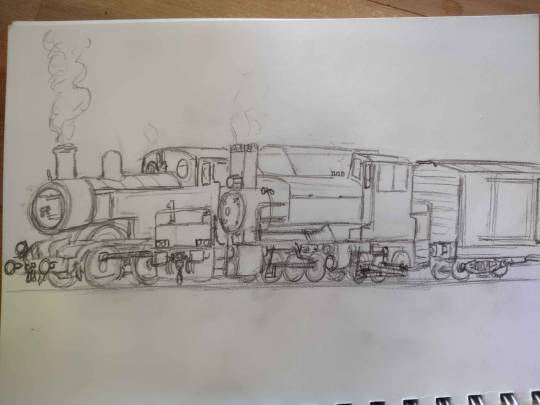
And when I got home i decided, hey, I have my Thomas 3D model, and I have the game model of the Advanced Steam Tank Engine... why not actually stage them together and draw them to-scale. The size difference is greater than I expected--partly I think this is because the Thomas gauge-1 prop was not designed with scale in mind, so it's bigger than British Railways loading gauge. Granted, they are at different gauges (standard gauge versus roughly meter-ish gauge), but the loading gauge on the advanced steam engine is very wide.
My first attempt at the drawing was from a very different angle:

But I quickly realized that you can't actually see the Advanced Steam Engine's wheels, and that's a major design aspect.

So i chose a different angle.


I constructed the dual gauge track before anything else.

And before long (the better part of 2 hours) I had the line art finished.
The Advanced Steam Engine ended up being a hybrid between the original illustration I did of it months ago, and the game model--with most of the geometry accurate to the game model, but with the subtler detailing of the illustrated version.
Thomas was meant to be a sort of hybrid of the Gauge 1 Prop from the TV series and a realistic loco. I prioritized the geometry and simplicity of the gauge 1 prop in most respects, but added details below the running board, in particular brake rigging, sanding gear, and these blade-like protrusions of the frames which i'm pretty sure are some kind of debris deflector, a british version of a cowcatcher. There's also snifters on the cylinder saddle, and the whistle is made of two different lengths to justify Thomas' multi-tone whistle.

The original background was going to be this marshland with (electricity-generating) windmills in the background, a callback to that first shot in the Thomas & Friends opening credits, but I hated how it felt like the middle of nowhere, so I introduced the retaining wall and an alien city scene.

British steam engines are generally given very shiny liveries which reflect the environment in interesting ways, so I made sure to do that justice, using a GWR 14xx autotank as reference.

By contrast, the Advanced Steam Tank Engine is kept in a more workwormlike condition, with a somewhat faded matte paint work and a fair amount of grime.
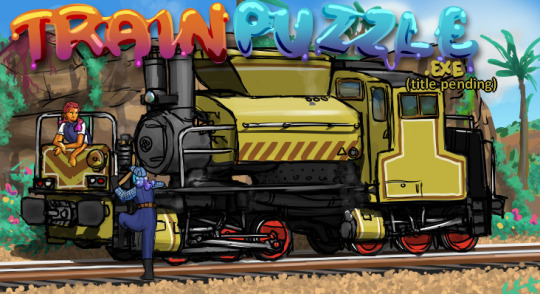
The original illustration of the advanced steam engine, for comparison.

Finally, a version with faces.
#advanced steam engine#tank engine#thomas the tank engine#ttte#train puzzle#mellanoid slime worldbuilding#train#steam train#ttte thomas#steam locomotive#worldbuilding#art#digital art#crossover
184 notes
·
View notes
Text

GAME: Spirit Tracks DIRECTORY: Height ref, #character tag
The youngest Royal Engineer New Hyrule has ever granted a graduation to, so he's kind of a prodigy when it comes to steam locomotives. This would be helpful — if only this weird Hyrule had any (he supposes he'll have to make do with these Zonai and Sheikah thingamajigs). Something of a stickler for respecting rules, boundaries, promises, and doing things by the book. The type who has trouble saying 'no'.

WEAPON: Came weaponless in the traditional sense. He's never had a taste for swordfighting despite his natural talent for it, so his sword and shield are usually left back at home with Niko when he's on duty. He brought everything else from his world-saving journey with Zelda though — he likes to handle foes with the whip and bow.
GEAR: Engineer must-haves. In addition to the occupational essentials, his items speak of a surprisingly careful youth. Several maps, a well-thumbed notebook, and two graphite pencils (complete with kneaded eraser) help bolster his memory; regularly washed handkerchiefs are always kept on hand to wipe off sweat, oil, and soot; miscellanea are organised safely in his pouch. Since he came with half his train, he has an emergency tool-chest available for its maintenance.
SKILL: Train engineer. Fully trained, educated, and officially recognised, Linh is an expert on the usage and upkeep of steam locomotives; they've been trying to see if any of their knowledge might apply to Zonai or Sheikah devices as well. The job's demands have also shaped their general conduct, in that they're a great multitasker and pay more attention to detail than their age would suggest.
SKILL: Spirit sight. Perhaps due to his Komo lineage, he can perceive the otherworldly without needing specialised magic or an enchanted item. This includes spirits, deities, auras if they're particularly bright, and right through some veiling spells if he concentrates hard enough.

LANGUAGES & COMMUNICATION: Hearing. He understands Hylian (Modern Syllabary), conversational Anouki and Goron, and limited Komo. Struggles with the Hylian commonly spoken in this Hyrule he's landed in, so he's among the heroes relying on Patches for interpretation at the moment. Non-speaking, he typically uses his era's Hylian Sign Language to communicate.
Has a whistle for train conducting; this is his go-to method for grabbing attention. It's had the unfortunate side effect of encouraging Cori to try stealing it off of him.
Fully literate, so he'll write in his notebook when faced with someone who doesn't know HSL.
KOMO LINEAGE: Born half-Hylian and half-Komo — of whom are a portion of the Indigenous Peoples of New Hyrule. He has smaller ears and more spiritual (rather than magical) ability than the rest of the party because of this. While not a complete stranger to Komo customs or knowledge, he was raised by Niko from a young age, so he's more familiar with Hylian culture.
Named Linh at birth, given "Link" when taken in by Niko due to the language barrier at the time.
PERSONAL TIMELINE: Went through the events of Spirit Tracks when they were eleven-years-old. It's been a year since. Does not go through Hyrule Warriors, only their Zelda does.
NICKNAME ORIGIN: It's just their birth-name. Cori signs this as its meaning ("spirit"); otherwise usually fingerspelled (syllabically, "Li-nn").


#linksconverge#links meet au#the legend of zelda#spirit tracks#zelda au#content / meta#lc linh#all the linkies are beloved but i must admit. linh has a most special place in the heart (< watch this guy say this about multiple links)#queue tag.
22 notes
·
View notes
Note
neurodivergent culture is watching steam locomotive valve gear spin
.
36 notes
·
View notes
Text
Day 16-Friends
Day 16-Golden
Other Stories
Other Days
Percy had just woke up when Cassandra snuck back into the sheds. The sidetank was clearly exhausted, the pouring rain slowly washing away soot and grime. She puffed laboriously as she reversed into the shed, clearly running on fumes more than any real head of steam.
He winced as she stopped next to him in her berth, her face looking little better than her paint. The cleaners quickly set about her with military precision.
“Morning,” she yawned, stretching her valve gear with a creak.
“Morning Cassandra,” he responded quietly, “successful night?”
She nodded blearily, “Caronia has them, they're safe now.”
‘ah.’ Percy thought, ‘she sent this batch to America.’
Cassandra yawned again, clearly struggling to stay awake.
“Are you okay?” Percy asked, concerned.
“I'm fine.” Cassandra reassured, even as he could see her struggling to keep her eyes open, “I just didn't get any sleep.”
Percy narrowed his eyes, “And when did you last sleep?”
Cassandra wearily considered the question, “...the night I was kept at Knapford.”
“That was four days ago!?” Percy squawked.
“Probably.” Cassandra said carelessly, closing her eyes.
The saddletank stared at his friend, “You need to sleep!”
The No.1 cracked an eye open irritably, “My next train is in thirty minutes, I’ll sleep tonight.”
“You can't haul a train like this!” Percy said aghast.
Cassandra signed in frustration, turning to glare at him, “and when it's asked why I'm not hauling my train?”
“Well I…”
“And the Other Railway's inspector realizes I've not slept in days and asks why?”
Cassandra's eyes swirled gold with her frustration. “No. I will haul my trains, my crew will see me through the day until I can sleep tonight.”
Percy shared a worried glance with Toby, who had woken during the conversation.
“Now if you excuse me,” Cassandra said firmly, “I have a train to arrange.”
“I’ll shunt it for you,” Percy volunteered, thinking quickly, “that way you can rest till its time for the train.”
Cassandra paused, “thank you.” She said, smiling tiredly but genuine.
She closed her eyes, clearly intending to nap for what little time she had.
Percy's driver looked towards him consideringly. Percy nodded. His driver nodded back and patted his bufferbeam. Percy started quietly, rolling forward quietly, his crew discreetly bracing themselves as he approached the points to the shed.
The tracks were well laid, and properly secured to North Western Standard. It didn't matter.
As Percy crossed the points he yanked left with all of his might. No matter how well secured, the rails could not fight the full might of a locomotive, and they separated from the sleepers with an ear piercing shriek as Percy fell between the rails with a booming thud, making sure to keep his wheels turning just a second too long.
The sudden silence afterward was deafening as the yard crews stared at Percy, sitting lopsidedly in a cloud of dust where the points used to sit
Percy could feel Cassandra staring wide eyed at him. He glanced down at his handiwork, and couldn't hide the smirk as he realized it would take several hours to repair the points after he had been removed.
“Oops.” He said.
#ttte fanfic#rws fanfic#fanfic#Traintober#Traintober24#Traintober2024#Prompt-Golden#ttte thomas#ttte Cassandra#ttte percy#ttte toby
12 notes
·
View notes
Text
South Australian Railways 620 class

South Australian Railways 620 Class Locomotive No. 620 "Sir Winston Dugan", builders photograph c.1936 Colourised be me : r/trains (reddit.com)
The South Australian Railways 620 class was a class of 4-6-2 steam locomotives operated by the South Australian Railways (SAR). built by the Islington Railway Workshops from 1936 to 1938. Fred Shea, the Chief Mechanical Engineer of the SAR designed a 140-long-ton (157-short-ton; 142 t) Pacific type. A notable feature of the design, unique to South Australian Railways, was the use of Baker valve gear instead of the more commonly used Walschaerts valve gear.
The class was made up of 10 locomotives, the first locomotive being built in 1936 at the Islington Railway Workshops, with the last being completed in 1938. Number 620, named Sir Winston Dugan, was Australia's first streamlined locomotive, the smokebox was covered with a chromed steel grille similar to those fitted to cars of the period, painted in resplendent Hawthorn Green and Silver. The press of the time described Sir Winston Dugan appearance as 'a bit of fluff'. The remainder of the class was not streamlined.

South Australian Railways 620 class number 621 is observed at Victor Harbor in its new black with red lining paint job, prior to this it had spent 50 or so years in green with yellow lining. : r/trains (reddit.com)
The 620 class replaced the Q and S classes on branch line services, where they proved successful. With the introduction of the more powerful and modern 520 class from 1943, the class was moved to the Willunga, Bridgewater and Tailem Bend passenger services and continued services on Murray Mallee line services. The classes light axle loading provided good route ability and the get up and go characteristics commonly found in large wheeled Pacific type locomotives.
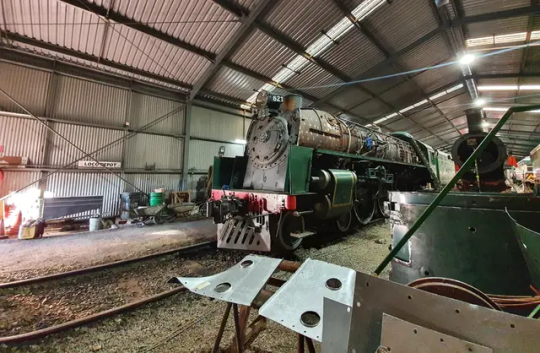
Undergoing Her 12 Year Inspection : r/trains (reddit.com)
The 620 class was phased out in of service in Favour of the Bluebird railcars, although number of railcar failures from 1954 to 1955 saw the class return to service on the Port Pirie line. All of the class were withdrawn between 1964 and 1969. Two of the class have been preserved: No.621 named the Duke of Edinburgh by SteamRanger and No.624 by the National Railway Museum, Port Adelaide.
Locomotive 624 - National Railway Museum (nrm.org.au)
Our Locomotive Fleet – SteamRanger Heritage Railway
videos of the class running:
620 Class Locomotives, Part 3: 621 and 624 Tours to Willunga - YouTube
Ex-SAR Class 620 -621 "Duke of Edinburgh" : r/trains (reddit.com)
Heritage Steam Locomotive SAR 621 Duke Of Edinburgh works upgrade in the Adelaide Hills 2/10/22 (youtube.com)
#australia#steam locomotive#australian steam engines#steam train#steam engine#south australia#south australian railways
11 notes
·
View notes
